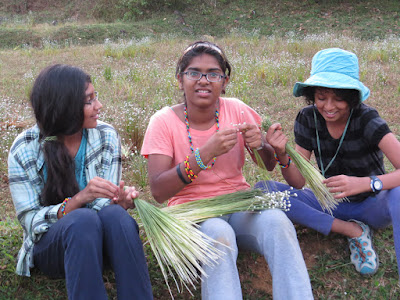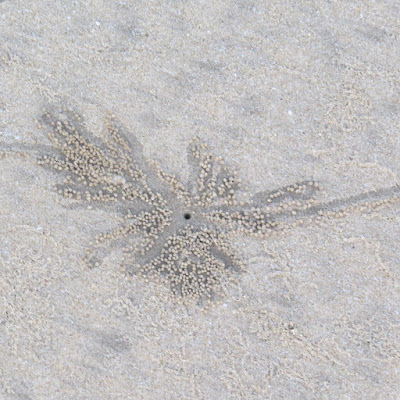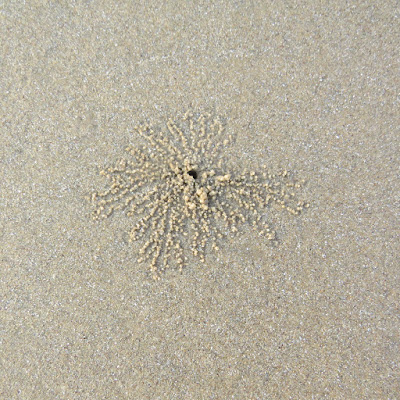 |
Setting Out: In Front of His Home in Bangalore
|
Sailesh cycled to Angadibail with his dog, Mac in a trailer, all the way from Bangalore. He is on a journey to discover a minimalist, sustainable way of life and BuDa Folklore, Angadibail is his first pit stop. He will stay here until the ‘Mungaru festival,’ the paddy transplanting event on 15, August.
*****
This story starts more than two decades ago. As a seven-year old, Sailesh decided to leave home over an altercation with his father. He walked out, sat on a nearby sidewalk and thought about what he would do to survive on his own. He thought he could catch fish for food. Then he began thinking about what it takes to catch fish: the tools and the skills to trap them. He went back home and began working on equipping himself with the skills of survival – of independence.
That seven year-old is now a successful architect with a business that he co-owns with two of his friends, in Bangalore. He is married to Maitreyi, a Bangalore-based writer, critic and poet. And he is finally living his dream of independence.
 |
| Where There's a Will... |
Ten days, 540 kilometers and over a thousand interesting conversations later, Sailesh made his first major stop at the forest centre in Angadibail.
Having visited the forest centre on a super-bike last year during Mungaru the paddy transplant season, Sailesh had decided to come back. And so, he did.
It does not take more than one conversation to realize that Sailesh is not just your regular architect. He is a biker, cyclist, trekker, rock climber, artisan, and wildlife enthusiast – among other things. Picking up survival skills has become his passion over the years – and miles.
*****
Pleased to have him in Angadibail, we ask him what made him drop in. This is a wild place, he says. For all its wilderness, it is still a relatively safe bet as he is familiar with the route, the place and the language. With ease of communication, his hope is to learn more about life in the wild and minimalist living. Also, the fact that it’s run by like-minded people makes a big difference – people who wouldn’t look askance at his ‘adventure’. On a long trip like this, one cannot carry anything beyond the functional. One also needs to know how to make and procure things on the go.
 |
| During Last Year's Paddy Plantation |
Sailesh hopes to learn a lot from Eshwar Anna, the multifaceted housekeeper at Angadibail. He also appreciates the chance to live alone, for the most part.
As an outdoors person, he hopes to settle down in a farm with “all” animals, a workshop and tools. He’s a self-taught handyman already and can work with wood, clay, cement, metal, and leather, to name a few substrates. He now hopes to learn the indigenous farming techniques practised at Angadibail. Aware that it is not an easy undertaking, Sailesh knows that while picking up skills, it is equally important to understand and anticipate mistakes. He feels that a minimum of three years of hard-work is required before one can expect to live by farming. He plans on staying at Angadibail during the monsoon and moving on after the paddy transplantation.
In the course of the year, he wishes to work his way around depending on money. He states quite confidently that he will never starve as he can ‘sing for his supper’ – which, of course, is rhetoric as he’s tone deaf! He could do hard labour and with an earning of half the minimum wage, he would still eat well, he insists.
*****
 |
| This Season's Sugarcane Plantation |
This one year's ‘break’ is not something that arose out of usual factors like job frustration or boredom. This is something that he has wanted to do for a long time – to travel for the sake of travelling and not for the destination; to not know where he is going next and to not have a specific timeline. With a year in his hand, he does not have to plan ahead: each day is a fresh perspective.
While he has cycled along the Nilgiri range and the Leh-Manali stretch previously, this is the first time he is covering this long a time and space – and definitely the first time with a dog. He is often called ‘crazy’ for the kind of things he does. In reality, he takes prepared and calculated risks. He is calm and steady and the least inclined to panic in an emergency. Fear, he adds interestingly, is what keeps him alive. This ‘fear’ isn’t a baseless paranoia, but a real, pragmatic need for awareness.
*****
 |
| Chariot of the Dog |
He designed and built a trailer for Mac and got him used to riding in it. There were a couple of trial runs to test the practicality of the size of the luggage. He had to reduce his luggage by several kilos after the pilot ride. His luggage now consists of a change of clothes, tools to fix the cycle, some medicines, a small solar panel and battery, water – and a large knife!
He cycles from 5.30 in the morning till noon and camps wherever he is. He has slept in temples, bus shelters and used his tarp when it rained. When on the road, from noon to late evening, most of his time is be spent answering endless 'why's, 'where from's and 'where to's.
Sailesh makes no bones about the rough part of the journey – cycling uphill in some places, for instance, is killing, he admits. And there are times he questions his own ability to do it. But he carries on nonetheless.
*****
 |
| Better Halves: Sailesh and Maitreyi |
He and his wife took a few months before he set out, to prepare for his journey. They worked towards downsizing their lifestyle, and material and emotional interdependence. They sold their car and one of their bikes. He also put up his prized super-bike for sale. He had dedicated a year to ‘do up’ their rented house in Bangalore: he had single-handedly built a roof-top oven, an aquaponics system with plants and fish, a full-fledged terrace garden, and a huge cage with birds of various descriptions in it. He dismantled it all, to his wife’s admiration – she was amazed that he could give up everything he’d worked for in order to follow his heart.
He credits his wife for making his journey possible. It helps that they are the best of friends rather than typical spouses, and understand and encourage each other’s individual interests. While they are very similar in their beliefs and ideals, they differ in their capabilities – as a writer, her life revolves around books and ideas, while he is the ‘doer’ who loves creating tangible things. Thus, they complement each other – and are always in awe of the other’s talents.
*****
 |
| Mending the Mat with Eshwaranna |
He is capable of building a house on his own. While the knowledge is a part of the package as an architect, he also possesses the required skills and physical strength to actually do it himself. He feels it is important to not let physical inhibitions stand in the way of working and is conscious about his fitness. His sense of being is centred on being completely independent: being capable of doing anything, and he constantly tests himself by this standard. This journey is part of that endeavour.
Since he was a child, Sailesh has always fantasized about living alone in a forest. In fact, he was quite radical about this idea: he felt that one was useless without this capability. While he has mellowed down considerably over the years and doesn’t hold such an extreme view anymore, one knows that he will always be that enterprising seven year old wanting to run away and fish, when he talks about hitting the roads after the monsoon, heading to Pune or Kerala or somewhere else altogether, with enough tools to dismantle a truck and his dear dog in tow.
Wherever he heads, BuDa Folkore wishes that its favourite cyclist, ‘Maitresh’ procures the best of tools, picks up the choicest of skills and travels happily ever after.
-- Meena Chockalingam, Intern, BuDa Folklore
*****
Glimpses of Sailesh's Life at BuDa Folklore
 |
| Dehusking Coconuts |
 |
| Mac Surveys his Terrain |
 |
| Sailesh and Eshwaranna Build a Pathway Through the Stream |
 |
In Preparation for the Paddy Field The Farmer Avatar    |


































































